

HAZOR
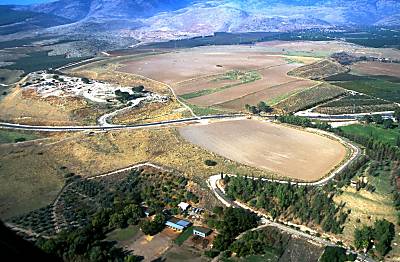 The first settlement of Hazor, in the third millennium BCE (Early
Bronze Age), was confined to the upper city. The lower city was founded in approximately
the 18th century BCE (Middle Bronze Age) and continued to be settled until the 13th
century (the end of the Late Bronze Age) when both the upper and lower city were violently
destroyed. Canaanite
Hazor is mentioned on several occasions in external records: it is first mentioned in the
19th century BCE in the Egyptian Execration texts and is the only Canaanite site mentioned
in the archive discovered in Mari (18th century BCE). The Mari documents clearly
demonstrate the importance, wealth and far-reaching commercial ties of Hazor. There are
also several references to Hazor in records of the military campaigns conducted by the
Egyptian Pharaohs, during the 15th - 14th centuries BCE. According to the Biblical
narrative, Jabin, the King of Hazor, headed a coalition of Canaanite cities against the
advancing Israelites, led by Joshua. The Israelites won the battle and Joshua burned and
ravaged the city (Jos. 11:1 - 12). Evidence of this violent destruction by burning was
discovered in various areas of excavation of the site. Another Israelite battle, this time
against a Canaanite army led by Sisera, Jabin's general, is described in the Book of
Judges, Chapter 4.
The first settlement of Hazor, in the third millennium BCE (Early
Bronze Age), was confined to the upper city. The lower city was founded in approximately
the 18th century BCE (Middle Bronze Age) and continued to be settled until the 13th
century (the end of the Late Bronze Age) when both the upper and lower city were violently
destroyed. Canaanite
Hazor is mentioned on several occasions in external records: it is first mentioned in the
19th century BCE in the Egyptian Execration texts and is the only Canaanite site mentioned
in the archive discovered in Mari (18th century BCE). The Mari documents clearly
demonstrate the importance, wealth and far-reaching commercial ties of Hazor. There are
also several references to Hazor in records of the military campaigns conducted by the
Egyptian Pharaohs, during the 15th - 14th centuries BCE. According to the Biblical
narrative, Jabin, the King of Hazor, headed a coalition of Canaanite cities against the
advancing Israelites, led by Joshua. The Israelites won the battle and Joshua burned and
ravaged the city (Jos. 11:1 - 12). Evidence of this violent destruction by burning was
discovered in various areas of excavation of the site. Another Israelite battle, this time
against a Canaanite army led by Sisera, Jabin's general, is described in the Book of
Judges, Chapter 4.
There followed sporadic occupation during the time of the Judges. A six chambered gate and casemate wall of the 10th century BCE can most probably be attributed to King Solomon (Kings 1, 9:15), during whose reign only the western part of the upper city was occupied. In the 9th century BCE, most probably under King Ahab, the city expanded. Hazor suffered repeated destruction, as a result of both the Aramean and Assyrian invasions. It was finally destroyed by the Assyrian King Tiglath-Pilesser III, who, in 732 BCE conquered the entire area of Galilee (Kings II, 15:29), in a campaign that marked the beginning of the end of the independence of the Northern Kingdom of Israel. (Adapted from the Hazor web site at http://unixware.mscc.huji.ac.il/~hatsor/history.htm)
FINDS AT HAZOR
ARTIFACTS
Religious
Buildings and Society
Destruction Levels
 Baal
worship: During the
Late Bronze Age, Hazor was a major center of Canaanite religion. The Canaanite god
is called "Baal", which means lord or master. Clay and/or metal
figurines representing this Canaanite god are very common in the Middle Bronze Age
to the end of the Late Bronze Age and many have been found at Hazor. This
figurine and the mask below may represent Baal. Often the
figurines show the god standing on a bull, a symbol of the stormy sky. In fact, one
of the names for Baal in the Ugaritic texts is "rider of the clouds." References to Baal are numerous in the Hebrew Bible. Here are two well known ones :
Baal
worship: During the
Late Bronze Age, Hazor was a major center of Canaanite religion. The Canaanite god
is called "Baal", which means lord or master. Clay and/or metal
figurines representing this Canaanite god are very common in the Middle Bronze Age
to the end of the Late Bronze Age and many have been found at Hazor. This
figurine and the mask below may represent Baal. Often the
figurines show the god standing on a bull, a symbol of the stormy sky. In fact, one
of the names for Baal in the Ugaritic texts is "rider of the clouds." References to Baal are numerous in the Hebrew Bible. Here are two well known ones :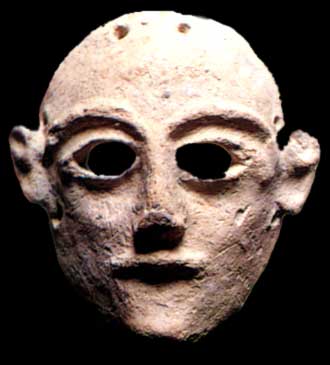
Judg 6:25-32 That night the LORD said to him, "Take your father's bull, the second bull seven years old, and pull down the altar of Baal which your father has, and cut down the Ashe'rah that is beside it; Then build an altar of the proper pattern to the Lord your God on the top of this earthwork; take the yearling bull and the offer it as a whole-offering with the wood of the sacred pole that you cut down.' So Gibeon took ten of his servants and did as the Lord had told him. He was afraid of his father's family and his fellow-citizens and so he did it by night, and not by day. When the men of the town rose early in the morning, behold, the altar of Baal was broken down.
Judg 8:33 As soon as Gideon died, the people of Israel turned again and played the harlot after the Baals, and made Baal-be'rith their god.
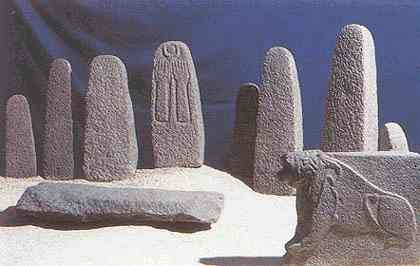 High Place, Bamah,
Standing Stones: "Bamah"
means "high place" and refers to a raised platform that served as an altar for
animal and other sacrifices in Canaanite religion. The high places and the temples around
them from the Middle and Late Bronze Age have yielded many cultic artifacts that help us
understand their religion. One of the temples at Hazor was decorated with basalt slabs and
standing stones. A depiction of raised hands on one of the stones perhaps represent
the worship of celestial deities, a common feature of Canaanite religion. As with
other such places of Canaanite worship, animal bones, cultic vessel, and ritual masks have
be found in the vicinity of the altar.
High Place, Bamah,
Standing Stones: "Bamah"
means "high place" and refers to a raised platform that served as an altar for
animal and other sacrifices in Canaanite religion. The high places and the temples around
them from the Middle and Late Bronze Age have yielded many cultic artifacts that help us
understand their religion. One of the temples at Hazor was decorated with basalt slabs and
standing stones. A depiction of raised hands on one of the stones perhaps represent
the worship of celestial deities, a common feature of Canaanite religion. As with
other such places of Canaanite worship, animal bones, cultic vessel, and ritual masks have
be found in the vicinity of the altar.
Four Room Houses:
Hazor was an important city in the Iron II period. Residential ho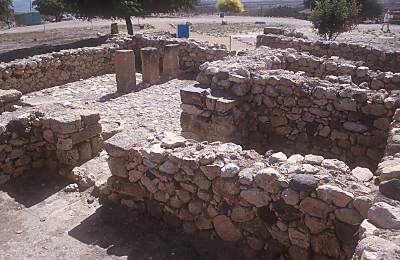 uses were built
very close together upon streets, often with a forecourt area that archaeologists believed
to be storefronts or shops. These houses are built according to the traditional
four-room house plan. In essence, the house would consist of four rooms built around
a central "patio". The people lived in the surrounding rooms while the animals
lived in the enclosed empty space in the center.
uses were built
very close together upon streets, often with a forecourt area that archaeologists believed
to be storefronts or shops. These houses are built according to the traditional
four-room house plan. In essence, the house would consist of four rooms built around
a central "patio". The people lived in the surrounding rooms while the animals
lived in the enclosed empty space in the center.
Palaces: At the west end of the city during Iron II a large palace was situated at Hazor. This palace was constructed of impressive ashlar (large, rectangular) masonry and casemate walls and contained two long rooms encompassed by smaller rooms on three sides, similar to the style of the four room house. Large palatial buildings are also found at Megiddo and Gezer, though they vary somewhat in design. A large public storage complex and granary on the lower terrace of the mound indicates that Hazor may have also been a center for royal food administration.
Fortification/Gates and Casemate Walls: King Solomon is credited with building the Millo, a terrace system in Jerusalem, and reconstructing three cities (1 Kings 9:15-17). Excavations at Hazor, Megiddo, and Gezer have all found gates and wall systems that follow the "same" plan. Based on this passage from the Bible and the striking resemblance of gates at all three sites, scholars have suggested that the fortifications at Hazor, Megiddo, and Gezer date to the 10th century BCE, that is, the time of King Solomon's reign. A similar gate at Lachish gate may also date to this period, but many archaeologists think it was built later, in the 9th century.
Water system: Hazor
contains one of the most elaborate water systems 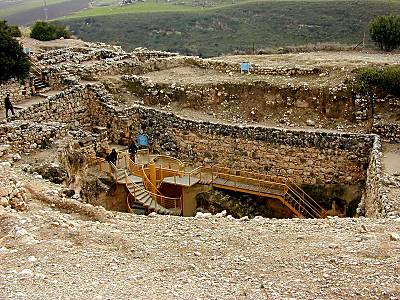 in ancient Israel. Located at
southeastern edge of the city, Hazor's water system is dated to the time of King Ahab in
the 9th century BCE. A huge shaft leads to wide stairway with 35 steps descending
into a 25 meter long tunnel. The width of the steps lead archaeologists to surmise
that mules were used for the transport of transport of water by mules. Though
not as wide or large, the water systems at Megiddo and Gezer are very is similar in
structure and design.
in ancient Israel. Located at
southeastern edge of the city, Hazor's water system is dated to the time of King Ahab in
the 9th century BCE. A huge shaft leads to wide stairway with 35 steps descending
into a 25 meter long tunnel. The width of the steps lead archaeologists to surmise
that mules were used for the transport of transport of water by mules. Though
not as wide or large, the water systems at Megiddo and Gezer are very is similar in
structure and design.
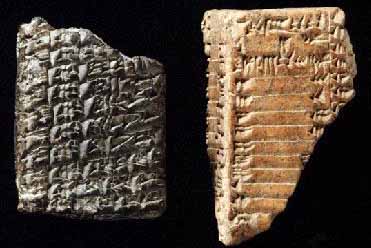 Cuneiform Tablets:
One of the most recently discovered finds at Hazor was the discovery of a palace with a
throne room. In the 1996 excavation season archaeologists discovered four clay
cuneiform tablets. These tablets, inscribed in the Akkadian language, include a list
of goods sent from Hazor to Mari (an important trade city in Mesopotamia). Scholars
have dated these tablets to the Middle Bronze Age.
Cuneiform Tablets:
One of the most recently discovered finds at Hazor was the discovery of a palace with a
throne room. In the 1996 excavation season archaeologists discovered four clay
cuneiform tablets. These tablets, inscribed in the Akkadian language, include a list
of goods sent from Hazor to Mari (an important trade city in Mesopotamia). Scholars
have dated these tablets to the Middle Bronze Age.
Destruction by Assyrians: The Israelite city of Hazor was destroyed by the Assyrian King Tiglath-Pileser III in 732 BCE. Following this destruction the city was not again occupied. This invasion is mentioned in the Bible:
2Kgs 15:29 In the days of Pekah king of Israel Tiglath-pileser king of Assyria came and captured I'jon, A'bel-beth-ma'acah, Jan-o'ah, Kedesh, Hazor, Gilead, and Galilee, all the land of Naph'tali; and he carried the people captive to Assyria.
Take me back to the regional map
Take me back to the Assignment Page